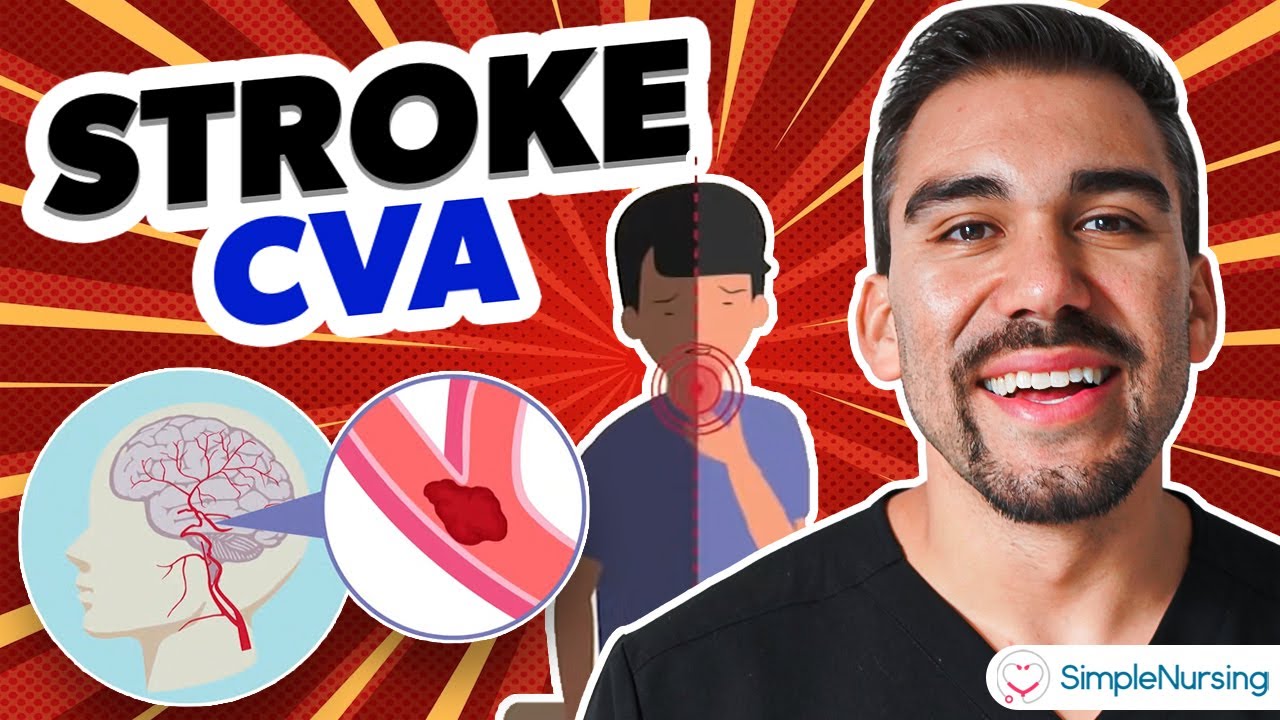Hemorrhagic stroke: intracerebral hemorrhage - causes, symptoms, diagnosis, treatment, pathology
Summary
TLDRThis video explains the two main types of stroke: hemorrhagic and ischemic. It focuses on intracerebral hemorrhages, which occur when an artery in the brain ruptures, causing a blood pool that increases intracranial pressure and deprives brain tissue of oxygen. The script covers brain anatomy, blood flow, and causes of intracerebral hemorrhage, such as hypertension and arteriovenous malformations. Symptoms like facial drooping, arm weakness, and speech difficulties are discussed, along with diagnostic methods and treatments including medications, craniotomy, and stereotactic aspiration. The acronym FAST helps remember stroke symptoms for timely intervention.
Takeaways
- 😀 Hemorrhagic stroke occurs when an artery ruptures and bleeds within the brain, while ischemic stroke is caused by a blockage in the artery.
- 😀 Intracerebral hemorrhage, a type of hemorrhagic stroke, involves bleeding within the cerebrum and is more common than subarachnoid hemorrhage.
- 😀 The cerebrum is divided into two hemispheres with four lobes: frontal, parietal, temporal, and occipital, each with specific functions.
- 😀 The brain receives blood supply from the internal carotid arteries and vertebral arteries, which form the Circle of Willis, ensuring circulation even in case of blockages.
- 😀 Hypertension is the most common cause of intracerebral hemorrhages, leading to vessel wall abnormalities and increased risk of rupture.
- 😀 Charcot-Bouchard aneurysms are small bulges in artery walls, typically found in small vessels like lenticulostriate arteries, that can rupture and cause hemorrhages.
- 😀 Conditions like arteriovenous malformations, vasculitis, and cerebral amyloid angiopathy can increase the risk of intracerebral hemorrhages.
- 😀 Hemorrhagic conversion occurs when an ischemic stroke leads to a secondary hemorrhage due to reperfusion or return of blood flow to damaged tissue.
- 😀 Increased intracranial pressure from bleeding can cause brain herniation, where the brain moves across skull structures, worsening the injury.
- 😀 Stroke symptoms vary depending on the affected brain region, with FAST (Facial drooping, Arm weakness, Speech difficulties, and Time) being a common mnemonic to recognize stroke signs.
Q & A
What are the two main types of strokes?
-The two main types of strokes are hemorrhagic strokes, which occur when an artery ruptures and bleeds within the brain, and ischemic strokes, which occur when an artery gets blocked.
How are hemorrhagic strokes further divided?
-Hemorrhagic strokes can be further divided into two types: intracerebral hemorrhage, where bleeding occurs within the cerebrum, and subarachnoid hemorrhage, where bleeding occurs between the pia mater and the arachnoid mater of the meninges.
What is an intracerebral hemorrhage?
-An intracerebral hemorrhage is a type of hemorrhagic stroke where bleeding occurs within the brain tissue, particularly in the cerebrum. If the blood extends into the ventricles, it's called an intraventricular hemorrhage.
What are the functions of the cerebrum’s lobes?
-The cerebrum consists of four lobes: the frontal lobe, which controls movement and executive functions; the parietal lobe, which processes sensory information; the temporal lobe, which is involved in hearing, smell, memory, and visual recognition; and the occipital lobe, which is primarily responsible for vision.
How does hypertension contribute to intracerebral hemorrhage?
-Hypertension can lead to vessel wall abnormalities like hyaline arteriolosclerosis, where proteins are pushed into the vessel walls, making them stiff and brittle. This increases the likelihood of vessel rupture and an intracerebral hemorrhage.
What is a Charcot-Bouchard aneurysm?
-A Charcot-Bouchard aneurysm is a microaneurysm that forms due to hypertension. It typically affects small arteries like the lenticulostriate vessels and can lead to intracerebral hemorrhages when ruptured.
What is a common complication of ischemic stroke that can lead to hemorrhagic stroke?
-A common complication of ischemic stroke is hemorrhagic conversion, which occurs when reperfusion, or return to blood flow, causes a ruptured vessel in the ischemic tissue, leading to a hemorrhage.
How does an intracerebral hemorrhage affect the brain’s functioning?
-An intracerebral hemorrhage increases intracranial pressure, which can damage brain tissue by compressing it and depriving it of oxygen-rich blood. This pressure can also lead to brain herniation, where parts of the brain shift within the skull.
What acronym is used to help remember stroke symptoms, and what does it stand for?
-The acronym FAST is used to remember stroke symptoms. It stands for Facial drooping, Arm weakness, Speech difficulties, and Time, which reminds individuals to seek help quickly to minimize damage.
What are the main treatment options for intracerebral hemorrhage?
-Treatment for intracerebral hemorrhage may include medications to control hypertension and intracranial pressure. Surgical options like a craniotomy or stereotactic aspiration can be performed to remove accumulated blood and relieve pressure.
Outlines

This section is available to paid users only. Please upgrade to access this part.
Upgrade NowMindmap

This section is available to paid users only. Please upgrade to access this part.
Upgrade NowKeywords

This section is available to paid users only. Please upgrade to access this part.
Upgrade NowHighlights

This section is available to paid users only. Please upgrade to access this part.
Upgrade NowTranscripts

This section is available to paid users only. Please upgrade to access this part.
Upgrade NowBrowse More Related Video

STROKE Lengkap - Klasifikasi, Patofisiologi, Skor Siriraj, Gajah Mada, Latihan Soal UKMPPD

Ischemic Stroke - causes, symptoms, diagnosis, treatment, pathology

What Causes a Stroke?

Stroke CVA (Cerebrovascular Accident) Hemorrhagic, Ischemic NCLEX RN & LPN NURSING

Brain Stroke, Types of, Causes, Pathology, Symptoms, Treatment and Prevention, Animation.

AVC DO PIRULLA: o que REALMENTE ACONTECEU e COMO EVITAR
5.0 / 5 (0 votes)